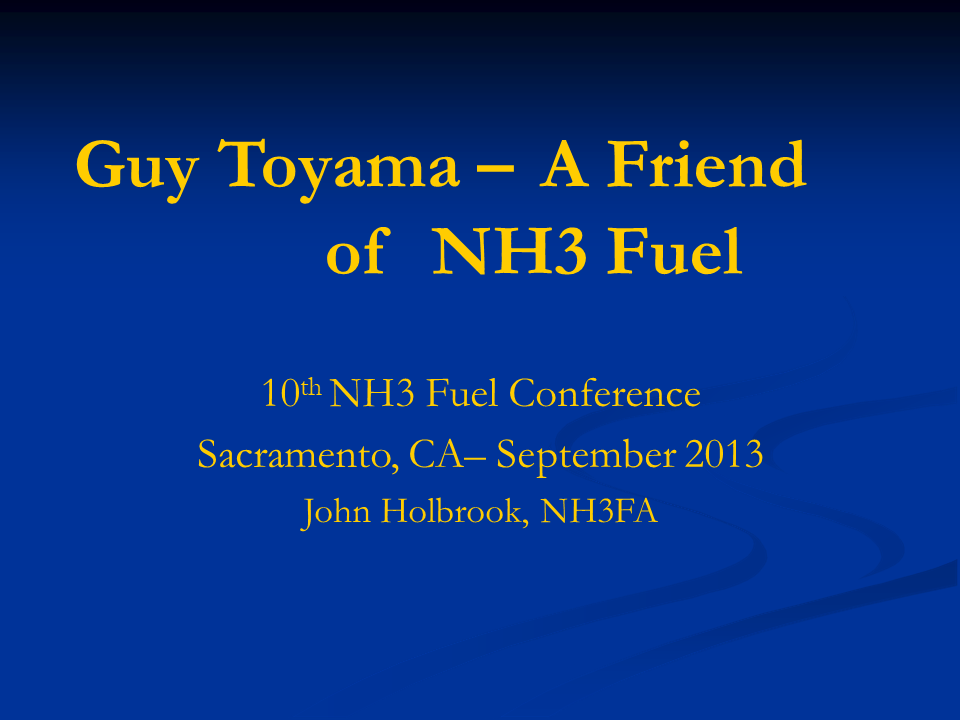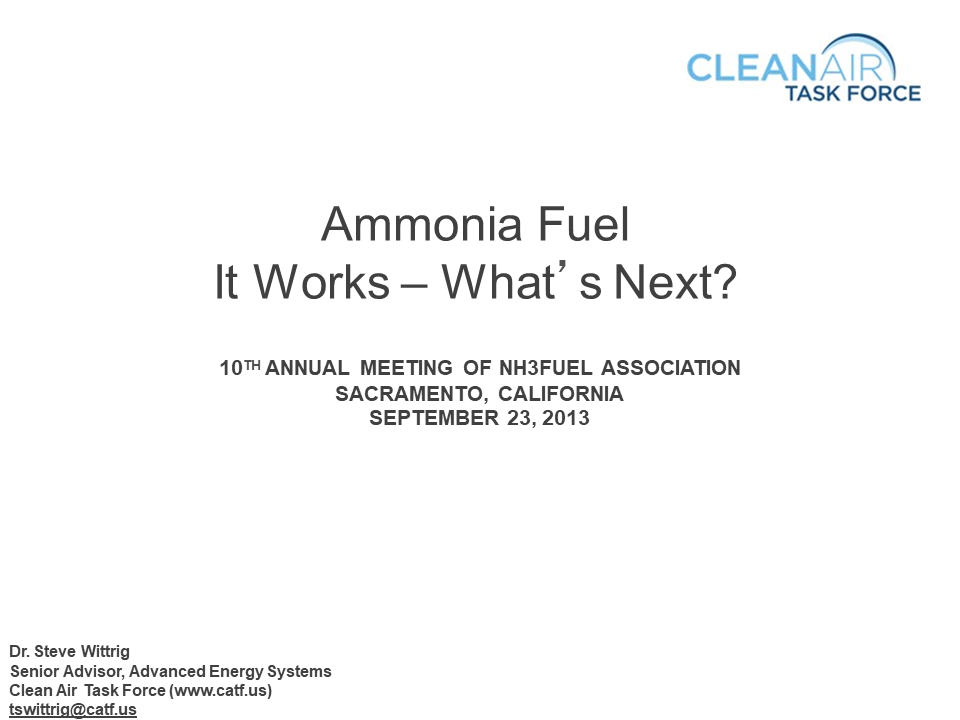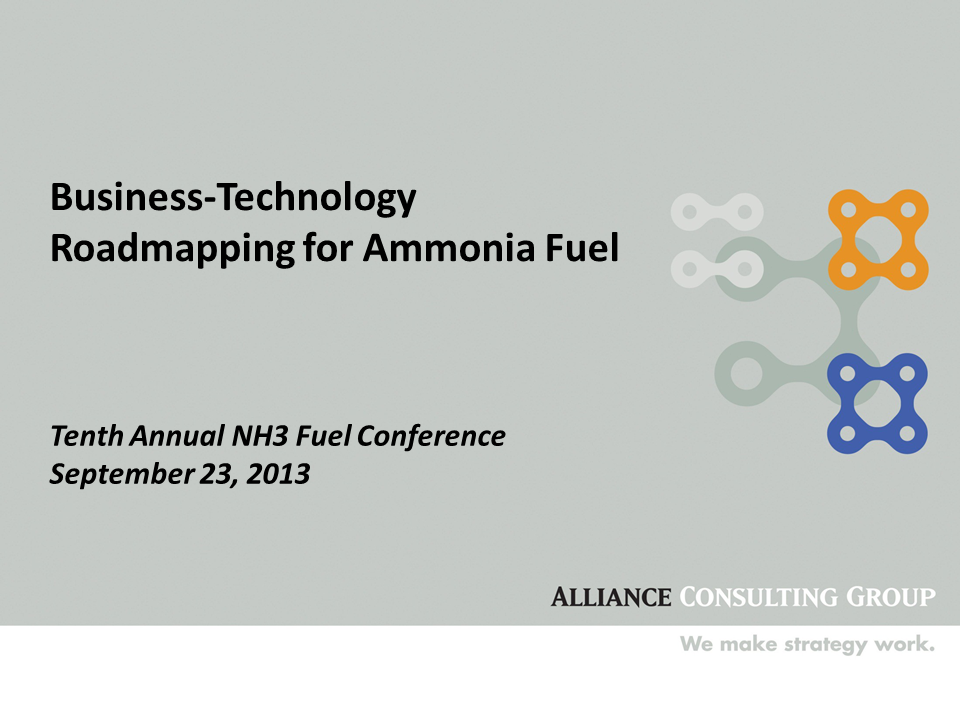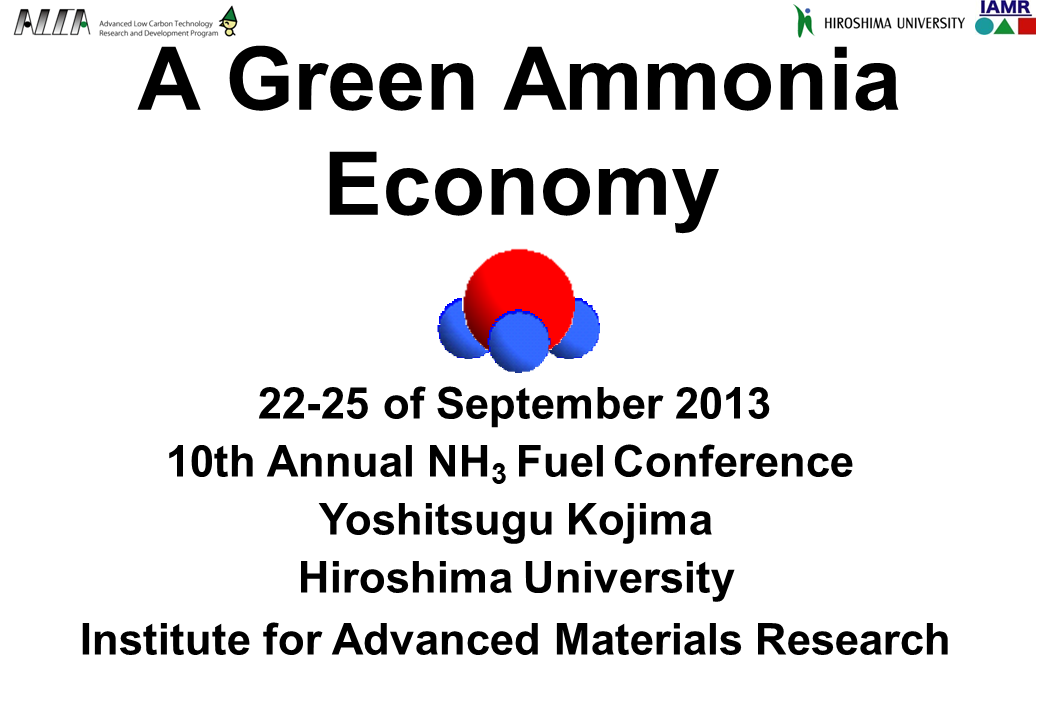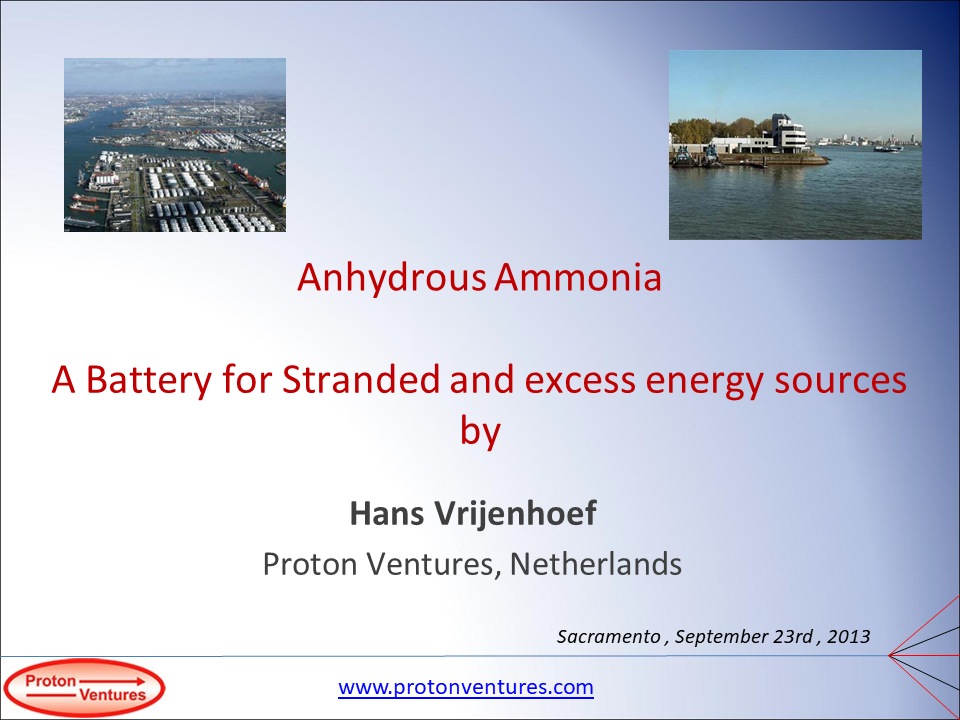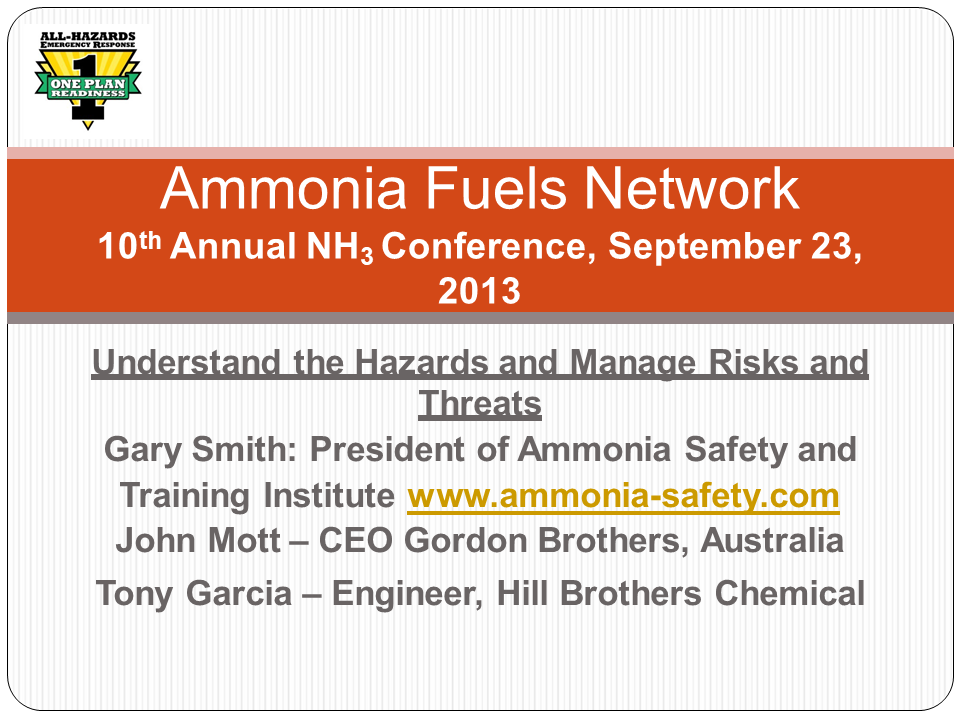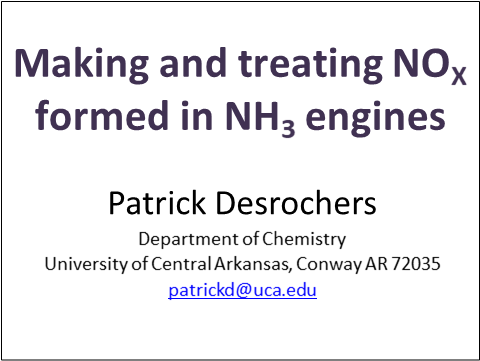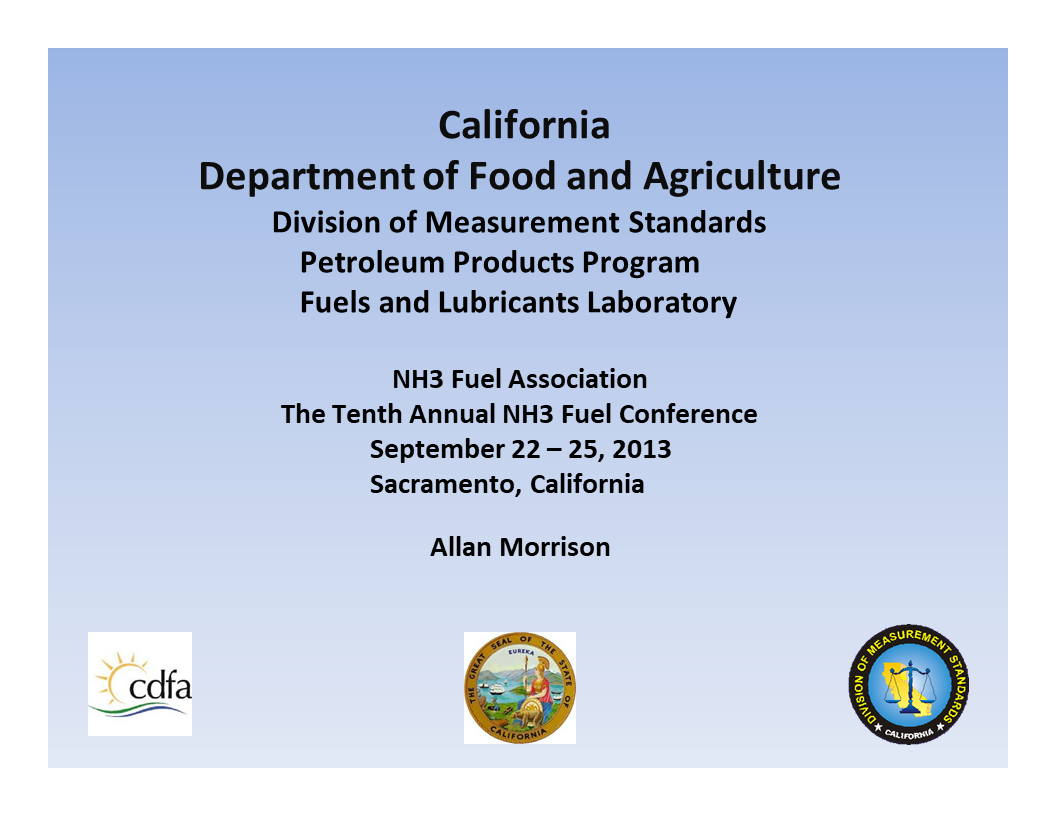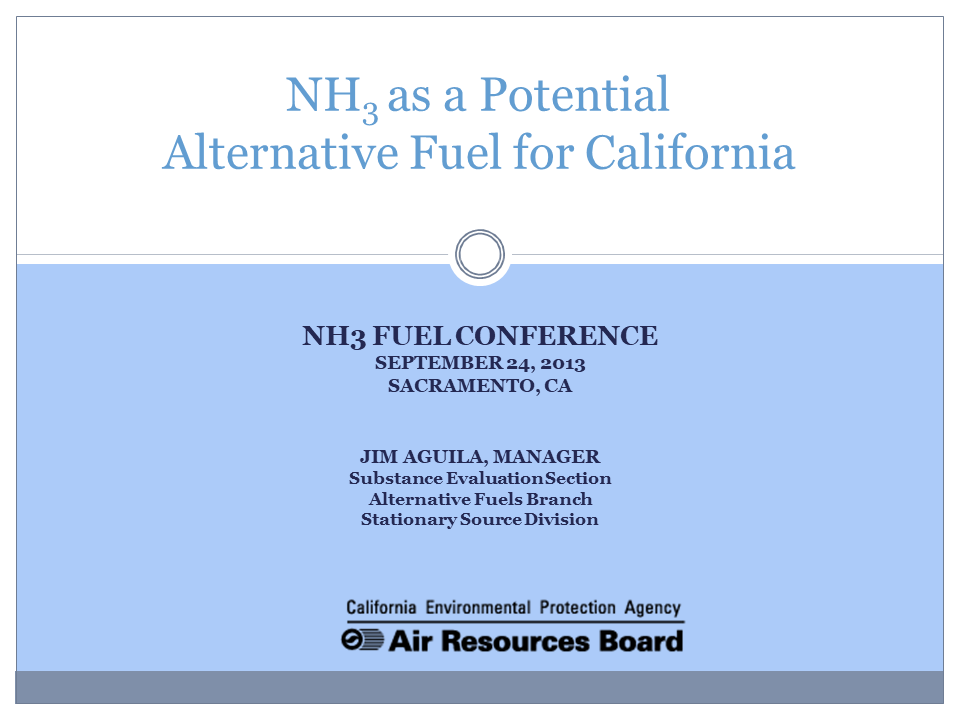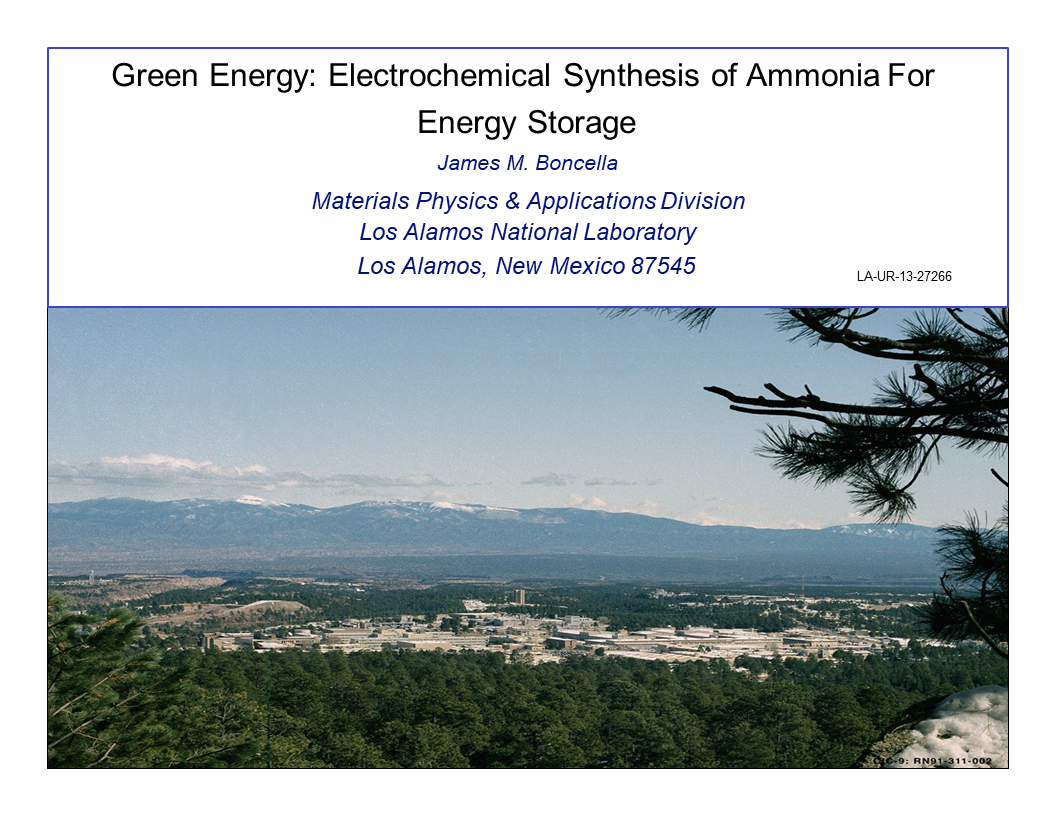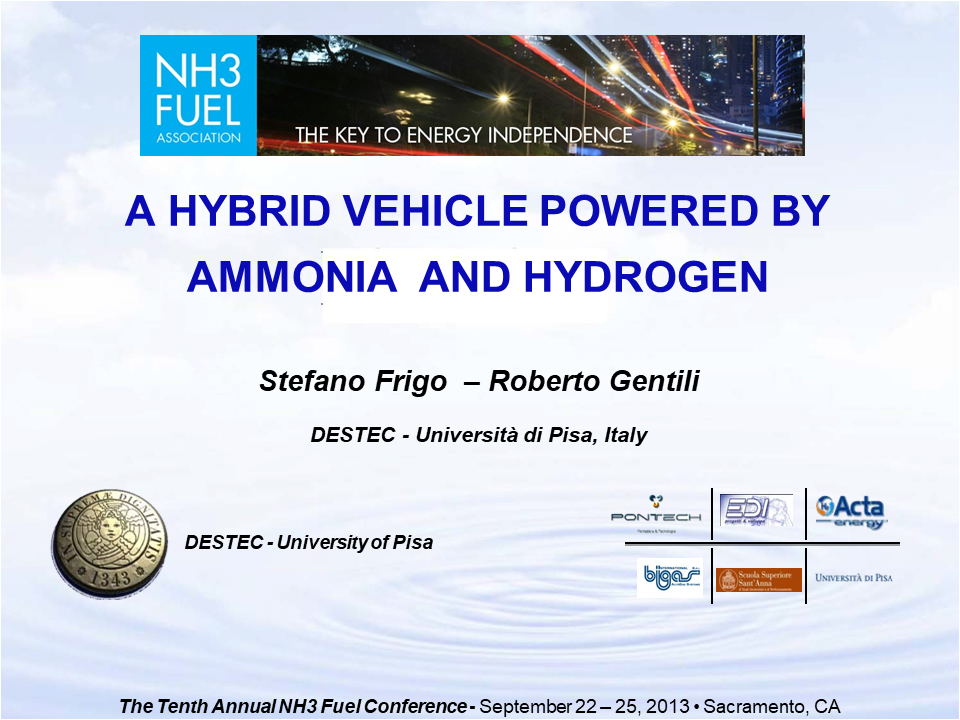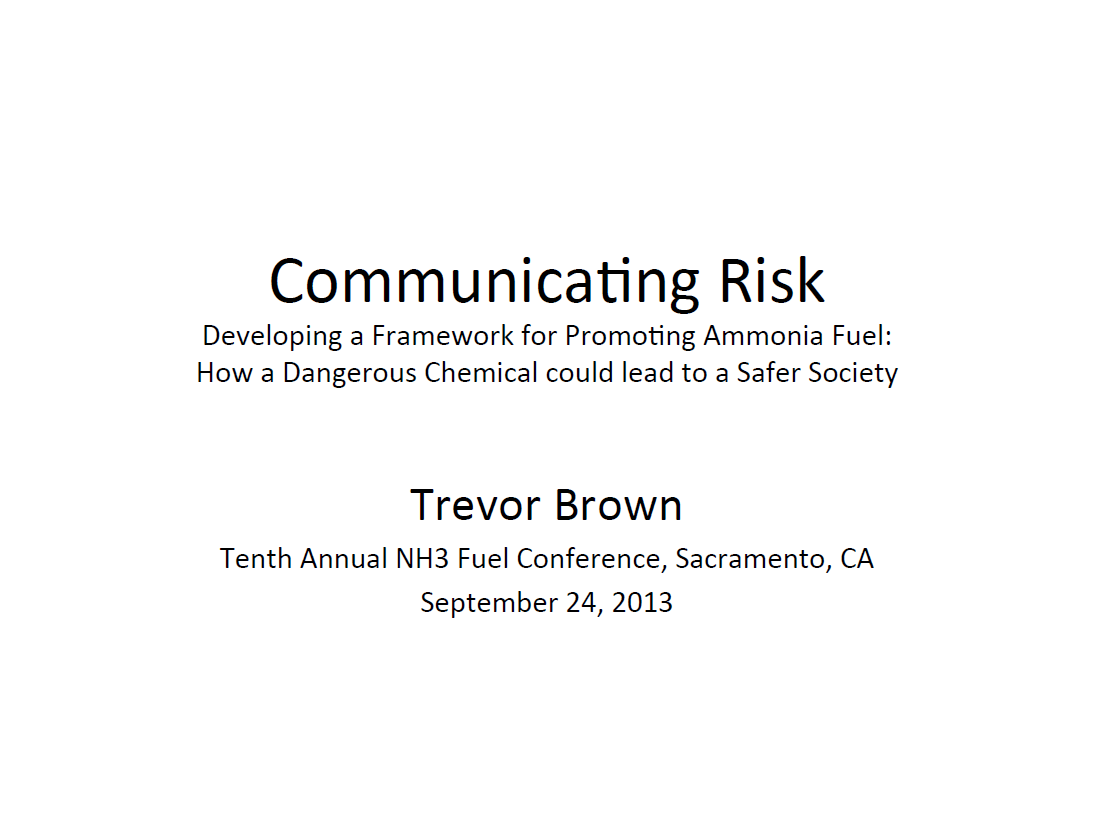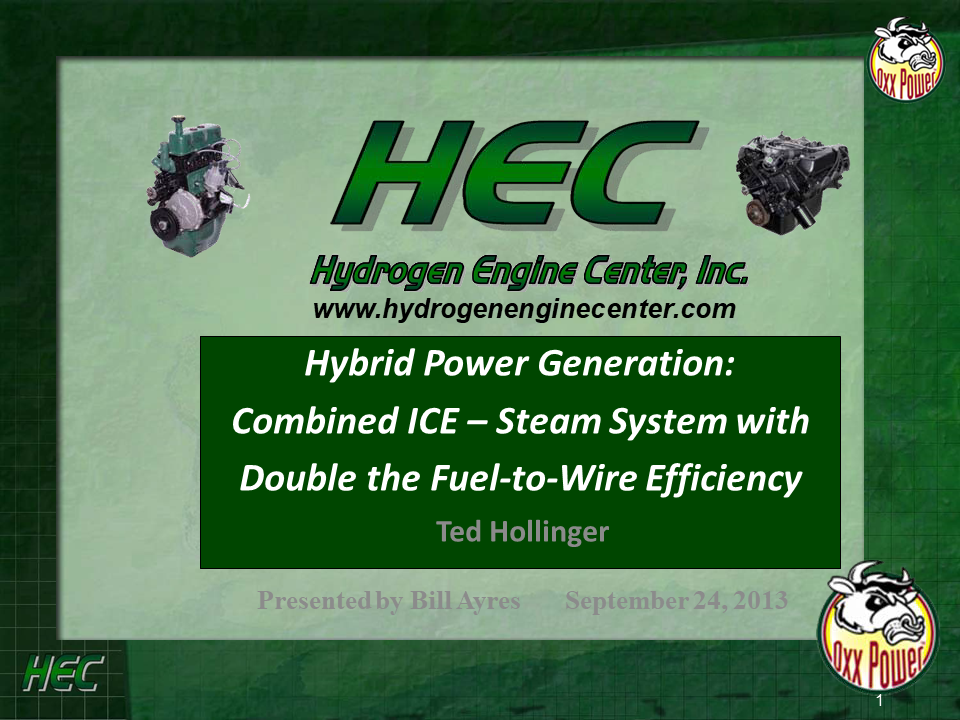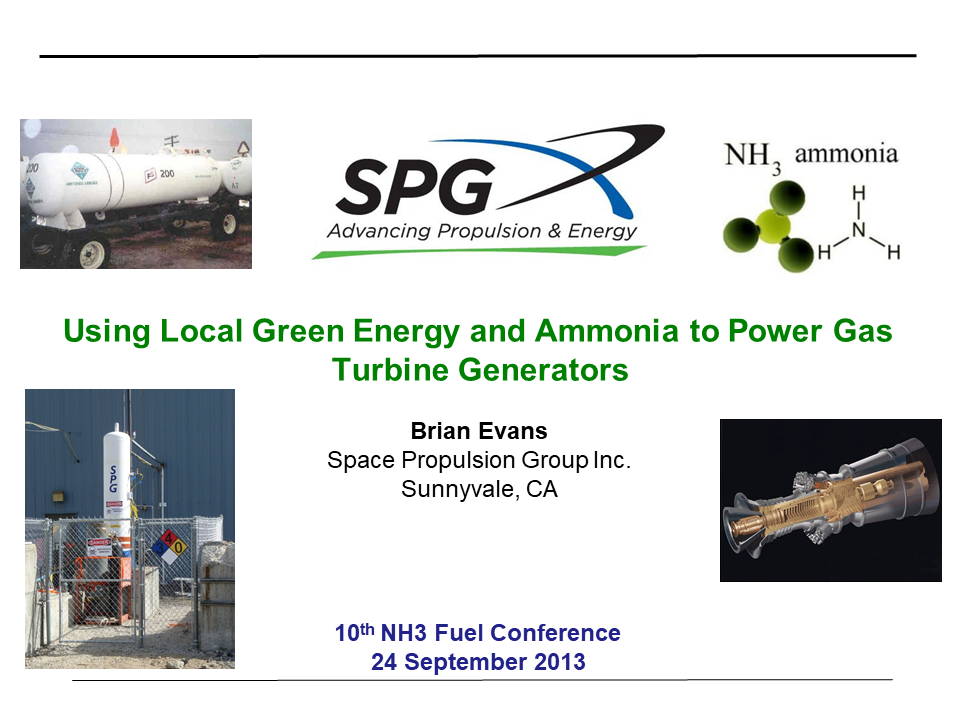NH3 Fuel Conference 2013
September 23, 2013 September 24, 2013 Embassy Suites Sacramento Sacramento United States
22 -25 September 2013
Schedule
Day One 2013 Conference
Monday, September 23, 2013
Presentation
Guy Toyama Memorial
Remembering a Special Friend of NH3 Fuel — Guy Toyama John Holbrook, Executive Director, NH3 Fuel Association
Presentation
Ammonia Fuel — It Works, Now What
KEYNOTE ADDRESS: Ammonia Fuel — It Works, Now What Steve Wittrig, Clean Air Task Force
Presentation
NH3 Fuel — Gaining Momentum
This paper provides an overview of the impressive characteristics of NH3 as a fuel. NH3 is the closet thing to an ideal fuel due to its production flexibility, competitive cost, infrastructure cost/availability, efficiency, environmental performance, and safety. This year’s presentation will emphasize why NH3 is the best bridge fuel between fossil and renewable fuels and why it is relatively simple to make NH3 safe enough to meet the most stringent existing fuel safety standards.
Presentation
Business and Technology Roadmapping for NH3 Fuel
Business and Technology Roadmapping for NH3 Fuel Stephen Crolius, Alliance Consulting Group
Presentation
A Green Ammonia Economy
Ammonia has a high volumetric hydrogen density of 107.3 kg H2 per cubic meter, because it is easily liquefied by compression below 0.86 MPa at 20° C. The vapor pressure of liquefied ammonia is similar to propane. Moreover it has a high gravimetric hydrogen density of 17.8 mass% compared with the solid state hydrogen storage materials. It is noteworthy that ammonia can be synthesized from hydrogen in large scale manufacturing by Haber–Bosch process at 400-600° C and 20-40 MPa. Therefore, liquid ammonia is one of the most promising methods for storing and transporting hydrogen. CO2 free hydrogen (ammonia) will be…
Presentation
Characteristics of a Spark Ignition Engine Using Direct Ammonia Injection
The effects of direct injection of gaseous ammonia on the combustion characteristics and exhaust emissions of a spark-ignition engine were investigated. Port-injection gasoline was used to enhance the burning of ammonia that was directly injected into the engine cylinder. Appropriate direct injection strategies were developed to allow ammonia to be used in spark-ignition engines without sacrifice of volumetric efficiency. Experimental results show that with gasoline providing the baseline power, total engine power increased as the injection timing of ammonia was advanced and the injection duration was increased. Engine performance with use of gasoline-ammonia was compared to that with gasoline alone.…
Presentation
Anhydrous Ammonia: a Battery for Stranded and Excess Energy Sources
Anhydrous Ammonia: a Battery for Stranded and Excess Energy Sources Hans Vrijenhoef, Proton Ventures
Presentation
Production of Ammonia and Nitrogen Fertilizers based on Biomass - Research Efforts in Sweden
The Swedish University of Agricultural Sciences have been conducting research on production of ammonia and nitrogen fertilizers based on bioenergy since 2006, in the last years in co-operation with Lund University and University of Minnesota. The research has so far been theoretical — studying the techno-economics and the potential environmental impacts. Several possible pathways for ammonia and ammonium nitrate fertilizer production have been explored, e.g. gasification of woody biomass, reforming of biogas from anaerobic digestion, integration in biomass CHP plants. A selection of results from the past years research can be presented: Techno-Economic Assessment of Non-Fossil Ammonia Production P. Tunå,…
Presentation
Ammonia Production Using Wind Energy: An Early Calculation of Life Cycle Carbon Emissions and Fossil Energy Consumption
Industry professionals and others have begun to consider the use of ammonia as a substitute for fossil energy in the fuel, fertilizer, and chemical sectors. Several factors are driving this concept; including, energy security concerns, the potential for economic development, and reducing the environmental consequences of fossil energy use. In terms of environmental concerns, it is important to determine the potential impacts of producing ammonia before a major switch to ammonia can be considered. This study examined fossil energy use and carbon emissions in the production of ammonia, using life cycle assessment (LCA) methods to analyze production at a novel…
Presentation
A Hazard Assessment of Ammonia as a Fuel: Understanding the Hazards and Managing the Risks / Threats of Ammonia as a Fuel
A Hazard Assessment of Ammonia as a Fuel: Understanding the Hazards and Managing the Risks / Threats of Ammonia as a Fuel Gary Smith, President, Ammonia Safety and Training Institute (ASTI), Tony Garcia, Hill Brothers Chemical Corp., and John Mott, General Manager of Gordon Brothers
Presentation
Making and Treating NOx formed in NH3 Engines
Ammonia has real promise as a green renewable fuel; however its use is not without some of the drawbacks endemic to high temperature combustion processes. Chief among them is the potential for NOx formation in nitrogen-rich oxidizing environments. Nitric and nitrous oxides are prime culprits that plague both entrenched hydrocarbon internal combustion technology but also emerging technologies like ammonia-as-a-fuel. Nitric oxide is implicated in photochemical ground-level ozone production in urban areas. Nitrous oxide is its own double-edged environmental sword, being both a potent tropospheric green-house gas as well as a principle agent in renewed stratospheric ozone-depletion (Science 2009, v326, p.…
Presentation
Mixed Protonic and Electronic Conductors for Solid State Ammonia Synthesis and Direct Ammonia Fuel Cells
Mixed Protonic and Electronic Conductors for Solid State Ammonia Synthesis and Direct Ammonia Fuel Cells J. Ganley, T. Olszanski, and N. Sullivan, Colorado School of Mines
Day Two 2013 Conference
Tuesday, September 24, 2013
Presentation
Ammonia as a Motor Vehicle Engine Fuel from a Weights and Measures Perspective
California Law requires: — All motor vehicle fuel must have a consensus organization fuel quality standard. In absence of such a standard, a user may obtain a “Developmental Engine Fuel Variance” for the purpose of developing a consensus organization standard. — Devices that measure for purposes of charging are type approved for product delivered and sealed by a Weights and Measure official. — Fuel dispensers are labeled in accordance to State and Federal requirements. — Unit of sale be in dollars per gallon or liter. The author provides an overview of these areas and information on how to obtain a…
Presentation
NH3 as a Potential Alternative Fuel for California
NH3 as a Potential Alternative Fuel for California James Aguila and Mike Waugh, California Air Resources Board
Presentation
Electrochemical Synthesis of Ammonia For Energy Storage
Electrochemical Synthesis of Ammonia For Energy Storage James Boncella and Fernando Garzon, Los Alamos National Laboratory
Presentation
Ammonia as an Energy Carrier for Renewable Energy
At present, ammonia is mostly formed through reforming of natural gas (CH4). A 1,000 ton per day plant is said to consume about 35 GJ of natural gas to produce 1 ton of ammonia (22.5 GJ of enthalpy). About 50% of extra energy is wasted. If 1 ton ammonia is produced through water electrolysis, 22.5 GJ of electricity is necessary theoretically. Here again, extra electric energy must be wasted. The author discusses roughly how the efficiency depends upon the process size and the renewable energy cost.
Presentation
Electrochemical Ammonia Synthesis from Water and Nitrogen using Solid State Ion Conductors
Jong Hoon JooChung-Yul YooSi Young JangJi Haeng YuHa-Na JeongChan Hee HyeongHyung Chul YoonJong-Nam Kim
Besides its current applications, ammonia (i.e. carbon-free fuel) could play important roles in preparing for oil depletion and coping with climate change since it releases only nitrogen and water when burned. Ammonia contains 17.6wt% of hydrogen and has significant advantages over hydrogen in storing and transporting energy. The current industrial ammonia production is based on the Haber-Bosch process, which has the drawbacks of high greenhouse gas emission, reaching up to 2.16 kg CO2/kg NH3 and large energy consumption over 30 GJ/ton NH3 resulting from the production of the reactants and the high pressure-high temperature synthesis of ammonia. In order to…
Presentation
A Hybrid Vehicle Powered by Hydrogen and Ammonia
Paolo DarioRoberto GentiliNeri BonfantiGiuseppe PozzanaStefano FrigoNicolo DoveriVirgilio MattoliMarina Ragnoli
A partnership of Research and Industry entities has developed a fully working hybrid electric vehicle equipped with a 15 kW IC engine fuelled with liquid ammonia as a range extender of the lithium batteries pack on board. The entire vehicle powertrain (ie, the IC engine, the electric generator coupled with the engine, the electric motor, the electronics etc.) has been studied and designed. Regarding the IC engine, as is known, ammonia combustion is characterized by a high activation energy and a low flame velocity, therefore a small amount of hydrogen is requested as igniter and combustion promoter. The necessary amount…
Presentation
NH3 Fuel Progress at Hydrogen Engine Center
NH3 Fuel Progress at Hydrogen Engine Center Ted Hollinger, Hydrogen Engine Center
Presentation
Using Local Green Energy and Ammonia to Power Gas Turbine Generators
Beginning in the 1950s, a fundamental shift in the way information was electronically expressed and manipulated led to the “digital revolution” that has transformed — is still transforming — information systems and many major industries and that has given rise to the internet, social media, and instant very-low-cost communication (like this website). A good case can be made that a similar “revolution” is beginning — has already begun — to transform the energy systems upon which we all depend. This presentation will address the use of anhydrous (water-free) ammonia, NH3, as a realistic option for making a fundamental shift in…
Presentation
Clean Cities Overview / City of Sacramento Green Fleet Update
Clean Cities Overview / City of Sacramento Green Fleet Update Keith Leech, City of Sacramento
